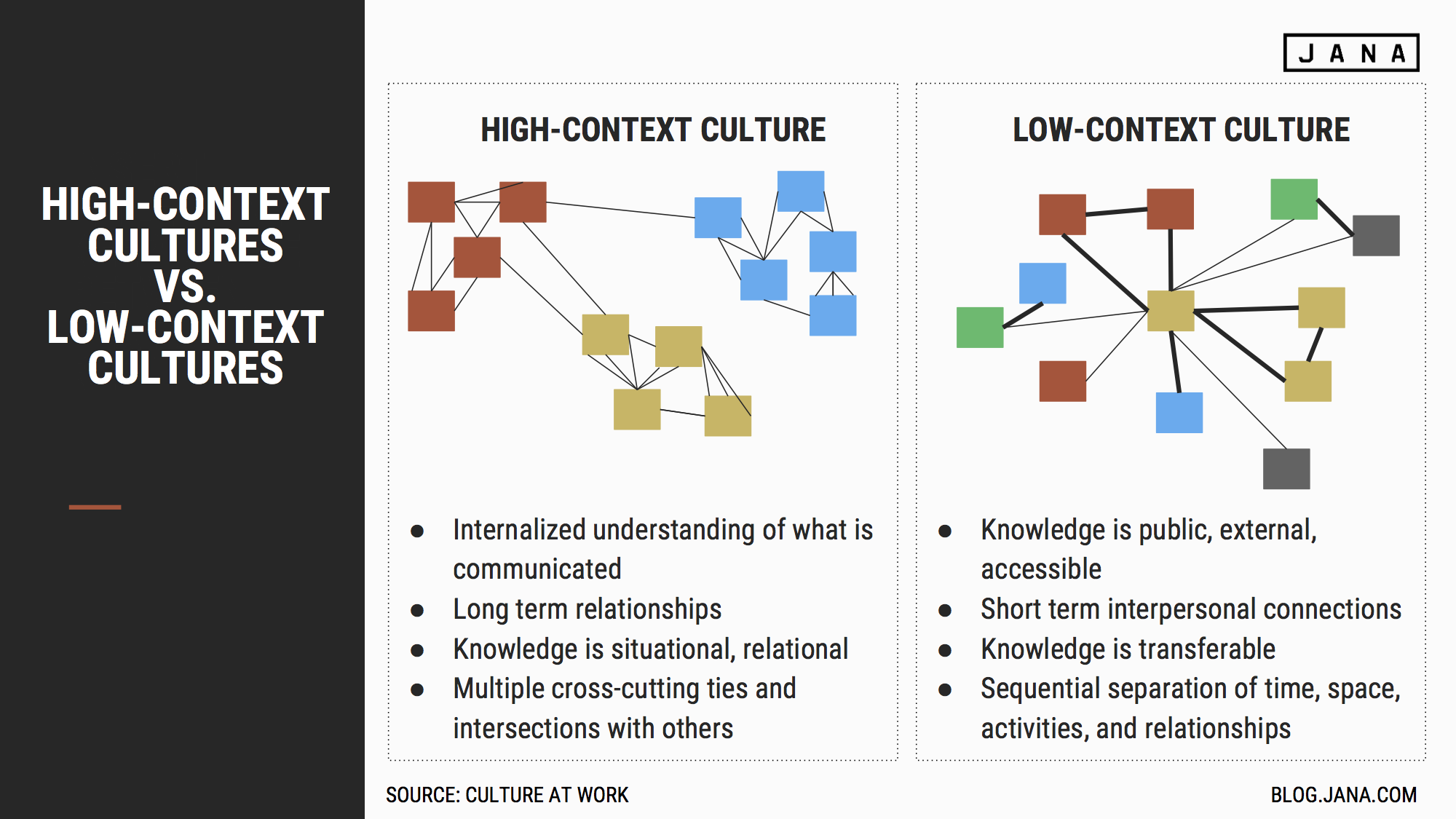The Death of Context
Kate Edwards / Geogrify

As content creators and/or co-creators working alongside the principal writers, artists and project managers, we are keenly aware of the importance of context when generating content that will be consumed on a global basis. I think especially in the cases of localization and culturalization professionals, context is so critically important to our work because so much depends on conveying the right information across linguistic and cultural barriers. Without all the proper contextual cues and metadata, our jobs become extremely challenging – if not even impossible in some cases.
Many experts have long-discussed the nature of context, especially from a cultural perspective and probably most notable among them is Dr. Edward Hall and his concepts of high and low context (see diagram). This refers to the differences in cultures based on communication styles, so that high context cultures require a lot of local linguistic cues that help frame the message. By contrast, in low context cultures, messages can be communicated without as many cues, thus the message has the potential for greater understanding outside its original locale/culture. This brief video (from Tero Trainers) provides a good explanation of the core differences between high-context and low-context cultures.
Dr. Hall’s framework helps us understand some of the fundamental differences in how messages are perceived across a variety of cultures. Most people who work in the content industries have some awareness of cultural cause and effect, realizing that an action made in one context can lead to either positive or negative reactions in another context. Some of these reactions are quite predictable while others may seem completely irrational. The way that a local consumer will react to the content has much to do with the context in which they personally exist, such as their faith, their ethnicity, their language, their location, and so forth. Also consider the other contexts in which the consumer operates – their social connections, their economic status, their educational background, the political environment, and so on. Thus, there are a lot of underlying reasons for why people in a specific culture react to certain content in one way or another, so it’s important to avoid making knee-jerk assumptions about how people respond.
In a simplified way, we can look at any specific culture as a combined set of “content assets” that clearly define the look, feel, sound, taste and general nature of the culture. Along with those assets come expectations for what will or will not fit within the norms of that culture. If we think about culture in this way, it’s easier to perceive how the content assets of an information product might conflict with the content expectations for what fits within a specific culture. Therefore, if the product contains a piece of content that doesn’t fit with the culture’s expectations or is noticeable enough to shock the consumer out of product’s intended focus (e.g., a word processor, a spreadsheet, a video game, etc.), then a potential problem may arise.
Culturalization is essentially an exercise in constantly evaluating the potential viability of a product in a target locale on the basis of contextual appropriateness, towards the goal of identifying potential risks and opportunities for a specific market. This applies not only to the context within the product, web page, etc. but also the context within the culture into which the product is being distributed. And part of that evaluation is the always-critical issue of discoverability, i.e., how easy is it for the information consumer to find the content element? Mostly typically, the biggest geopolitical and cultural mistakes occur when content intended for specific contextual audience (a language, culture, locale, etc.) is exposed to an unintended audience.
Over time, I’ve expected the unintended audience proportion to slowly decrease, as more people become digital natives and (assumedly) understand the nature of the context of the information with which they’re interacting. However, what’s been interesting in recent years has been two emerging trends among content consumers: 1) the cross-cultural, global appropriation of strongly local contextual issues, and 2) an apparent diminished ability (or desire?) to discern contextual cues and origins.
On the first point, much has been written and studied on appropriation as it relates to cultural anthropology and the transfer of pieces of culture from one to another. It’s been the case for the course of human history, and we’re only seeing it greatly accelerate now due to the hyper-compressed space and time distances, enabled by the ever-growing connectivity of individuals to the internet. While we see more and more people and cultures empowered by internet access, we see more previously local contextual cues either purposefully or accidentally adopted by others across a wide range of locales, and suddenly a once-obscure name, gesture, expression, etc. becomes the latest internet meme.
In regard to the second point about an inability to critically examine context, more content professionals have been reporting similar observations with the communities in which they work. In short, with the vast increase in global connectivity and information consumption, there seems to be growing knee-jerk response to anything that may even remotely be considered “offensive.” One potential cause is the stripping away of contextual cues and metadata around a piece of content, so that we experience an avalanche of online content without context – without which it’s almost impossible to perceive the original intent, which is a critical aspect of any communication.
Here’s a simple case in point. One example I often use in lectures involves two images: a human hand in an open palm gesture, and the other is the Nazi-style swastika as seen during World War II – both as seen below. The Greek “mountza” gesture is locally considered to be as offensive as flipping the middle finger in the U.S. I introduce these images by asking the audience: “Both of these are very negative symbols, but which one is more context-independent?” The juxtaposition of these images is meant to emphasize that context is critical to meaning. In this case, both images are offensive but the mountza requires more cultural context to obtain its specific meaning (i.e., high-context) while this particular swastika is self-explanatory (i.e., low-context); it’s an image that is so universally identifiable that regardless of the cultural context, it will likely be recognized.

Despite using this example for educational purposes, I’ve heard increasingly more people express concerns that using a swastika in any context, even a Buddhist swastika (such as the Japanese manji symbol), is intolerable. This feedback has arisen particularly from younger consumers and students, which makes me ponder if there’s a connection with digital natives and their typically voracious social media consumption and in turn, an implicit familiarity with perceiving content without context.
As we’ve seen in recent years, social media has the ability to completely negate context and foment emotions purely based on what one sees in a punctuated moment without considering the metadata around why the content is being displayed. Indeed, exploiting this core dynamic of social media – the emotional knee-jerk – is at the center of current allegations around Russia’s meddling in the 2016 presidential elections in the United States, as well as information warfare in other countries.
While I realize this may make me sound like an old veteran ranting about a disruptive youth culture, that’s not the intent. As someone who’s entire career has been built around discerning and analyzing the context of information, I have growing concerns that when we lose our ability to understand and appreciate the context of the information we consume, we lose our ability to learn, to seek wisdom, and to gain perspective from other people, times, and cultures. All of these are fundamental aspects to how we as human beings and as a society build upon and advance our collective knowledge and progress.
The next time you see something in social media or elsewhere that triggers that immediate, knee-jerk rage based purely on what you’re perceiving, take a moment to step back and try to discern the intent and context around that content before taking a course of action.
Image Credits:
1. High-context culture vs. low-context culture.
2. Greek mountza vs. swastika.
Please feel free to comment.
This is an interesting and constructive take on what may be the ultimate reason for the phenomenon of online (verbal) violence that has been growing more and more common nowadays. The distinction between the functionality of context within a product, i.e. infused during the production process, and within the cultural space where the product is distributed is crucial. As content creators aim at be increasingly politically correct through reducing the influence of their own context over the product that they produce, the consumers are even more aggressively dismissing the very notion of this set of context. In other words, consumers are assuming that the product is, or should be, catered specifically to their context that is on the receiving end. Offense is no longer an issue with one party being actively offensive, instead, it is with the active “taking” of it from the other party. As can be inferred from the article, with the deminishing ability/desire to discern contextual origins, an overwhelming portion of the labor that contributes to the product’s successful transcultural distribution is thus put on the creators, which may further harm both the production and consumption of globalized contents.
This article’s analysis of differences between high-context culture and low-context culture and the diminishing of context in social media is quite inspiring and leads me to wonder what might be the context characteristic of new media. Unlike real society, the cyberspace largely shields people’s true identities and differences in their social status and provides the equal rights of communications. It is because of the virtual nature of cyberspace that netizens can rip off camouflage and be outspoken, and can even emotionally express their opinions on reality, thus forming a unique discourse pattern for the users of the Internet of new media – open, straightforward, and sharp. These features are already fundamentally different from Hall’s description and categorization of high-context culture (such as the implicitness, silence, and minimal exposure of meanings in verbalization). The social characteristics of the new media era, such as the interaction and fusion of online and offline, the virtual space and real society facilitate the development of “virtuality” as a feature of new media context. Moreover, the death of context can be seen in the confusion of user identity caused by the generalization of “friend” relationship on many social network sites. Some social media platforms might have the characteristics of a living community at the beginning of their birth, and the users might have profound and specific daily experiences with tags like “family”, “friends”, “colleagues” etc.. However, with the continuous increase of functions on those websites, for many users, the relationships among communication circles on social media have become more complicated. Most of their newly added friends come from professional contacts with professional names as remarks, and the identities of those “friends” are determined by professional activities. The relationship established between members is a kind of instrumental relationship of cooperation and exchange, whereas the user’s identity is only a functional identity that can hardly have the meanings of emotional support and in-depth recognition. When sharing posts on Facebook with the default setting of “Friends”, users are in fact sharing something with all of the groups and more. In this way, the already less clear contexts of different groups would further collapse and become one.
thanks for this